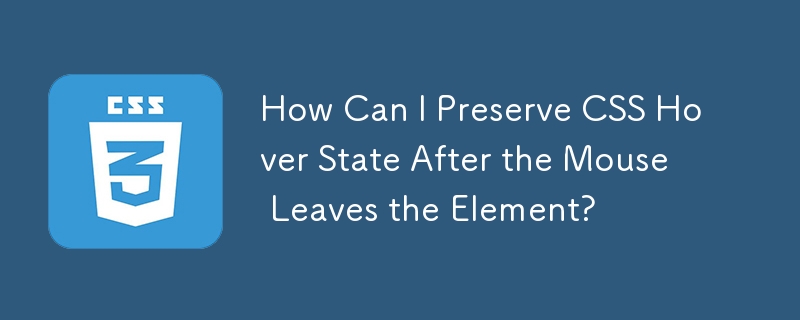 Web Front-end
Web Front-end
 CSS Tutorial
CSS Tutorial
 How Can I Preserve CSS Hover State After the Mouse Leaves the Element?
How Can I Preserve CSS Hover State After the Mouse Leaves the Element?
How Can I Preserve CSS Hover State After the Mouse Leaves the Element?

Preserve CSS Hover State After "Unhovering"
In web design, the hover state is commonly used to display additional content on mouse hover. However, by default, this content disappears when the mouse cursor leaves the specified area. This article presents a CSS solution to keep the hover state visible after "unhovering" the cursor.
The provided example utilizes the ':hover' pseudo-class to reveal an image when hovering over a div. However, the image disappears when the hover event ends. To address this, the following CSS technique can be employed:
div img {
position: absolute;
opacity: 0;
transition: 0s 180s;
}
div:hover img {
opacity: 1;
transition: 0s;
}
div {
line-height: 1.2em;
font-size: 1em;
color: black;
transition: 0s 180s;
}
div:hover {
line-height: 0;
font-size: 0;
color: transparent;
transition: 0;
}This code uses a combination of absolute positioning, opacity, and transitions to achieve the desired effect. The opacity is initially set to 0, making the image invisible. On hover, the opacity is set to 1, revealing the image. To prevent the content from disappearing on "unhover," the transition property is used with a delay of 180 seconds (3 minutes). This delay effectively inhibits the opacity transition, keeping the image visible indefinitely.
Alternatively, it is also possible to use focus events to ensure that the image remains visible when clicked:
div:hover img:focus {
opacity: 0;
transition: 3s;
-webkit-transform: rotate(-360deg) scale(0.23);
-webkit-transform: rotate(-360deg) scale(0.23);
-moz-transform: rotate(-360deg) scale(0.23);
-o-transform: rotate(-360deg) scale(0.23);
-ms-transform: rotate(-360deg) scale(0.23);
transform: rotate(-360deg) scale(0.23);
}This variant uses focus events and transitions to fade out and rotate the image after it is clicked, keeping it visible during the transition.
By implementing these CSS techniques, you can modify the hover state behavior to maintain the visibility of desired content even after the mouse cursor leaves the specified area.
The above is the detailed content of How Can I Preserve CSS Hover State After the Mouse Leaves the Element?. For more information, please follow other related articles on the PHP Chinese website!

Hot AI Tools

Undresser.AI Undress
AI-powered app for creating realistic nude photos

AI Clothes Remover
Online AI tool for removing clothes from photos.

Undress AI Tool
Undress images for free

Clothoff.io
AI clothes remover

Video Face Swap
Swap faces in any video effortlessly with our completely free AI face swap tool!

Hot Article

Hot Tools

Notepad++7.3.1
Easy-to-use and free code editor

SublimeText3 Chinese version
Chinese version, very easy to use

Zend Studio 13.0.1
Powerful PHP integrated development environment

Dreamweaver CS6
Visual web development tools

SublimeText3 Mac version
God-level code editing software (SublimeText3)

Hot Topics
 Vue 3
Apr 02, 2025 pm 06:32 PM
Vue 3
Apr 02, 2025 pm 06:32 PM
It's out! Congrats to the Vue team for getting it done, I know it was a massive effort and a long time coming. All new docs, as well.
 Building an Ethereum app using Redwood.js and Fauna
Mar 28, 2025 am 09:18 AM
Building an Ethereum app using Redwood.js and Fauna
Mar 28, 2025 am 09:18 AM
With the recent climb of Bitcoin’s price over 20k $USD, and to it recently breaking 30k, I thought it’s worth taking a deep dive back into creating Ethereum
 Can you get valid CSS property values from the browser?
Apr 02, 2025 pm 06:17 PM
Can you get valid CSS property values from the browser?
Apr 02, 2025 pm 06:17 PM
I had someone write in with this very legit question. Lea just blogged about how you can get valid CSS properties themselves from the browser. That's like this.
 Stacked Cards with Sticky Positioning and a Dash of Sass
Apr 03, 2025 am 10:30 AM
Stacked Cards with Sticky Positioning and a Dash of Sass
Apr 03, 2025 am 10:30 AM
The other day, I spotted this particularly lovely bit from Corey Ginnivan’s website where a collection of cards stack on top of one another as you scroll.
 A bit on ci/cd
Apr 02, 2025 pm 06:21 PM
A bit on ci/cd
Apr 02, 2025 pm 06:21 PM
I'd say "website" fits better than "mobile app" but I like this framing from Max Lynch:
 Using Markdown and Localization in the WordPress Block Editor
Apr 02, 2025 am 04:27 AM
Using Markdown and Localization in the WordPress Block Editor
Apr 02, 2025 am 04:27 AM
If we need to show documentation to the user directly in the WordPress editor, what is the best way to do it?
 Comparing Browsers for Responsive Design
Apr 02, 2025 pm 06:25 PM
Comparing Browsers for Responsive Design
Apr 02, 2025 pm 06:25 PM
There are a number of these desktop apps where the goal is showing your site at different dimensions all at the same time. So you can, for example, be writing
 Why are the purple slashed areas in the Flex layout mistakenly considered 'overflow space'?
Apr 05, 2025 pm 05:51 PM
Why are the purple slashed areas in the Flex layout mistakenly considered 'overflow space'?
Apr 05, 2025 pm 05:51 PM
Questions about purple slash areas in Flex layouts When using Flex layouts, you may encounter some confusing phenomena, such as in the developer tools (d...





